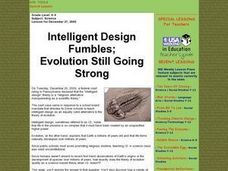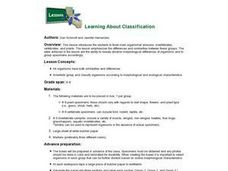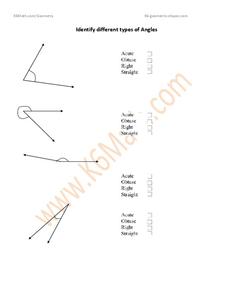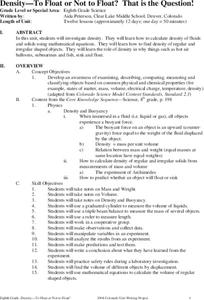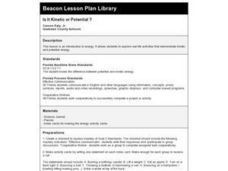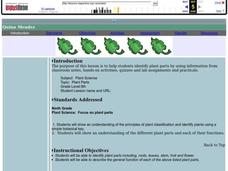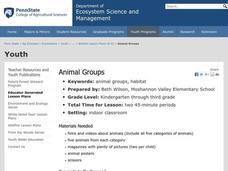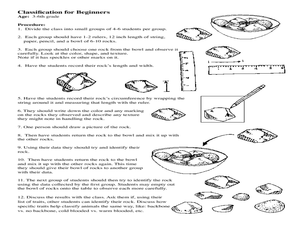Curated OER
Name That Point!
Students compare projectile point attributes, identify and classify points, and match projectile points to a chronology.
Curated OER
Intelligent Design Fumbles; Evolution Still Going Strong
Students examine how all life is related and how species are classified. They also discover how traits are passed down from one person to the next. They examine the evolution the arthropod has going through.
Curated OER
Learning About Classification
Students explore the three main organismal divisions. Students classify organisms by invertebrates, vertebrates, and plants. They observe the differences and similarities between these groups.
Curated OER
Will it SINK or Float?
Students predict whether objects will sink or float in water. They classify objects as sinking or floating in water. Students identify and explain similarities between objects that sink and float.
Curated OER
A Planet Full of Animals
Students study animals and practice classifying them through observation activities. In this animal classification instructional activity, students complete a KWL chart about animals. Students then sort pictures of animals into chart...
Curated OER
Amoeba This!!! Amoeba That!!!
Students investigate protozoa. In this protozoa instructional activity, students identify and classify different types of protozoa using different ecological samples and protozoa charts.
Curated OER
Is There A Fungus Among Us?
Sixth graders classify fungus into two different groups. In this fungus lesson, 6th graders collect as many pieces of fungus as possible. Students then classify these pieces of fungus as saprophytic or parasitic.
Curated OER
Identifying Angles
In this angles practice worksheet, students respond to 4 questions that require them to identify the pictured angles as acute, right, or obtuse angles.
Curated OER
Exploring Properties of Rectangular Prisms
Students explore the properties of rectangular prisms. For this geometry lesson, students identify properties of two and three dimensional shapes. They use Cabri technology to create polygons and solve problems.
Curated OER
Density - To Float or Not to Float? That is the Question!
Students investigate how to find the density of fluids and solids using math. Students also learn how to find the density of regular and irregular shaped objects.
Curated OER
Length, Perimeter, and Area
Students explore the concepts of length, perimeter and area. Students develop an understanding of length, perimeter, and area. Students calculate the area and perimeter of random shapes and calculate the area and perimeter of a triangle...
Curated OER
Geometry in Tessellations
Students examine tessellations and their geometric properties. Students explore the concept of tessellations and lines, planes, angles, and polygons. Students experiment with the area and perimeter of polygons. Students analyze...
Curated OER
Forest Friends Forever
Pupils investigate how to use the senses to gather information about objects such as size, shape, color, texture, sound, position, and change (qualitative observations are utilized throughout this lesson plan). They investigate and...
Curated OER
What's the Matter?
First graders identify solids, liquids, and gases. In this matter lesson, the teacher guides students through numerous demonstrations as they determine the properties of solids, liquids, and gases and classify things as each. As the...
Curated OER
Is It Kinetic or Potential ?
Seventh graders explore real life activities that demonstrate kinetic and potential energy. They, in groups, classify the activity card statements as kinetic or potential. They should also include where the potential and kinetic energy...
Curated OER
Why is the Middle East so Stereotyped in the West?
High schoolers examine the stereotypes used to classify the Middle East. After taking a regional literacy survey, they discover their own global awareness. They discuss how stereotypes are formed and how they persist over time if not...
Curated OER
Pythagorean Theorem
Middle schoolers engage in a study of the Pythagorean Theorem to classify the hypotenuse of a triangle. The teacher uses examples from the lesson to aid students in comprehension of solving problems that involve problem solving. They...
Curated OER
Science: When Autumn Leaves Fall
Students conduct Internet research to discover the reason why leaves change color in autumn. On a nature walk around school grounds, they collect leaves of various colors and shapes over a three-week period. finally, students select...
Curated OER
Playing In The Dirt - Discovering Soil
Middle schoolers discuss some the different types of soil in Oklahoma. They identify the soil types and explore the characteristics of each type of soil. In groups, students perform hands-on activities such as taking soil samples,...
Curated OER
Plant Parts
Ninth graders identify plant parts by using different classification methods. In this plant lesson students observe and draw different types of leaves then classify them according to species.
Curated OER
Animal Groups
Young scholars explore animal groups. In this animal science lesson, students use pictures from magazines and classify the animals into five categories. Young scholars share why they categorized the animals the way they did.
Curated OER
Classification for Beginners
Students explore the process of classification. In this rock classification instructional activity, students conduct a scientific investigation that requires them to follow the provided steps to classify rocks.
Pennsylvania Department of Education
Extending Pattern Understandings
Learners use shapes and manipulatives to demonstrate patterns. In this patterns lesson plan, students also break up patterns to identify a pattern unit.
Curated OER
Rocks and Minerals
Take young geologists on an exploration of the collection of rocks and minerals that we call Earth with an upper-elementary science lesson. Through a series of class discussion and hands-on investigations, students learn about the...

